Table of Contents
The Science Behind Filipino Gamefowl Breeding
In the Philippines, gamefowl genetics breeding is more than a hobby — it’s a passion rooted deeply in culture, tradition, and science. Behind every successful fighting rooster is not just luck, but years of careful breeding, selection, and an understanding of gamefowl genetics. Filipino breeders have mastered the art of combining bloodlines, creating superior fighters known for their speed, stamina, strength, and cutting ability.
In this comprehensive guide, we dive into Gamefowl Genetics 101, revealing how Filipino experts select their breeders and build champion bloodlines.
The Importance of Gamefowl Genetics in Breeding
Why Genetics Matter
- Genetics determine key traits such as:
- Aggressiveness
- Cutting ability
- Stamina
- Speed
- Bone structure
- Mental toughness
- Breeders aim to create consistent lines that produce champions across multiple generations.

The Balance of Nature and Nurture
While training, nutrition, and conditioning are important, breeding provides the foundation. A well-bred gamefowl has the natural potential that training can fully unlock.
Key Traits Filipino Breeders Look for in Breeders
Before pairing a cock and hen, expert breeders evaluate multiple factors:
| Trait | Why It Matters |
|---|---|
| Body Conformation | Proper balance, muscle structure, and wing span affect fighting style. |
| Aggressiveness | Controls how willing the bird is to attack or defend. |
| Cutting Ability | Precision in landing fatal strikes. |
| Stamina | Ability to last in long, grueling matches. |
| Temperament | Calm but focused behavior increases fighting intelligence. |
| Line Consistency | Bloodlines must consistently produce offspring with desirable traits. |
Understanding Bloodlines: The Foundation of Gamefowl Genetics
Popular Bloodlines in the Philippines
- Sweater – Known for power, cutting accuracy, and finishing ability.
- Hatch – Recognized for strength and solid leg kicks.
- Kelso – Balanced style, with excellent defensive and offensive instincts.
- Roundhead – Fast, smart, and quick cutters.
- Lacy Roundhead – Combines speed with tactical footwork.
Pure vs. Cross Breeding
- Pure breeding focuses on strengthening and preserving key bloodline traits.
- Cross breeding (hybridizing) allows breeders to combine strengths from different lines to create a more complete fighter.
Filipino experts often apply both strategies, depending on their breeding goals.
How Filipino Breeders Analyze Gamefowl Genetics
Linebreeding
- A common method used to reinforce desirable traits while maintaining genetic consistency.
- Close relatives (but not too close) are paired to preserve key characteristics.
Outcrossing
- Bringing in a new bloodline to introduce fresh genes and eliminate weaknesses.
- Helps correct deficiencies such as weak legs or poor stamina.
Inbreeding (used sparingly)
- Breeding close relatives to “lock-in” a specific desirable trait.
- Risky if not carefully managed due to potential genetic defects.

The Selection Process: Step-by-Step
Observation of Parents
- Study the fighting performance of both sire (cock) and dam (hen).
- Watch for qualities like reflexes, accuracy, courage, and endurance.
Physical Inspection
- Inspect bone structure, balance, leg thickness, and wing span.
- Healthy appearance signals strong genes.
Test Breeding (Progeny Testing)
- Pairing birds and evaluating offspring through sparring sessions.
- Successful pairings are bred further, while poor-performing crosses are discontinued.
Culling
- Removing weak, defective, or undesirable birds from the breeding pool.
- Ensures only top-quality genetics are passed down.
Keeping Detailed Records
- Meticulous documentation of:
- Parentage
- Performance
- Health history
- Crosses attempted
Most professional breeders maintain detailed records, sometimes using software or apps.
The Science of Sabong: Breeding for Speed, Stamina, and Strength
The Role of Modern Technology in Gamefowl Genetics Breeding
DNA Testing
- Some breeders now utilize genetic testing to analyze hereditary traits and avoid inbreeding issues.
Breeding Management Software
- Allows tracking of thousands of birds, their bloodlines, and performance over time.
Global Networking
- International forums and groups allow breeders to exchange knowledge and acquire top-quality bloodlines from other countries like the USA, Mexico, and Thailand.
The Future of Filipino Gamefowl Genetics
As the sport continues to evolve, so does the science behind breeding:
- More scientific-based selection to reduce trial and error.
- Focus on durability and injury resistance due to changes in fight rules.
- Ethical breeding practices to ensure humane treatment of birds.
- Sustainable breeding programs preserving legendary bloodlines for future generations.
Genetics is the Heart of Champion Gamefowls
Behind every champion gamefowl stands years of careful genetic planning, evaluation, and experience. Filipino breeders have elevated gamefowl breeding into both an art and a science, blending traditional knowledge with modern techniques.
For those aspiring to breed future champions, understanding gamefowl genetics is not just optional — it’s essential.

Tell us your thoughts!
Are you passionate about gamefowl breeding?
Start studying your bloodlines, observe your breeders, and document your pairings.
Share your own breeding experiences and tips in the comments below!
Subscribe for more expert guides, bloodline profiles, and gamefowl breeding secrets.
Because in every great gamefowl match, the battle is won long before the fight — it starts in the breeding yard.
Frequently Asked Questions (FAQs)
What is the most important factor when selecting gamefowl breeders?
Breeders should prioritize genetic consistency — choosing parents with proven performance, strong physical structure, and the desired traits they want to pass on.
How does linebreeding help in gamefowl breeding?
Linebreeding strengthens specific desirable traits by pairing birds from the same bloodline while maintaining some genetic diversity to avoid defects.
Can crossbreeding produce stronger gamefowls?
Yes. Crossbreeding allows breeders to combine strengths from different bloodlines, creating more balanced and versatile fighters when done correctly.
How do breeders prevent genetic defects in gamefowl?
Breeders avoid excessive inbreeding, monitor physical and behavioral traits, conduct careful culling, and sometimes utilize modern DNA testing to minimize genetic weaknesses.
Is record-keeping important in gamefowl breeding?
Absolutely. Accurate records of pairings, offspring performance, and bloodline history help breeders refine their programs, track successes, and avoid repeating poor crosses.
